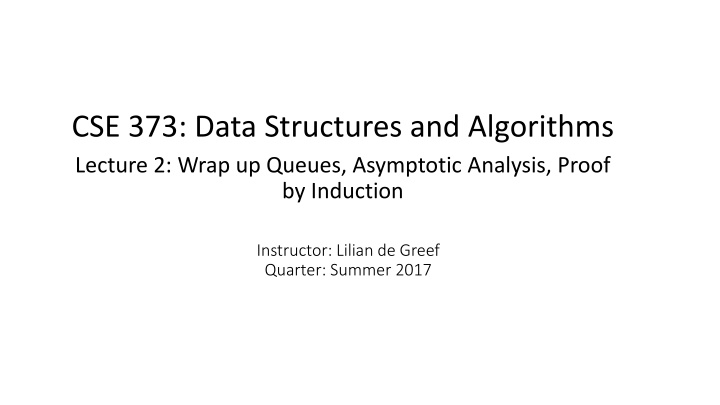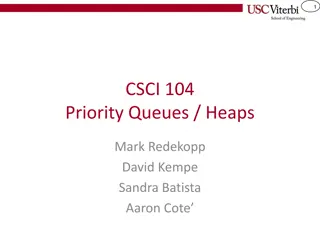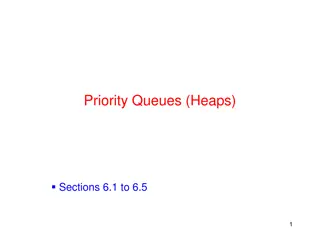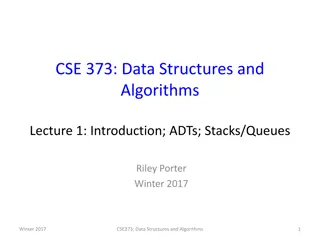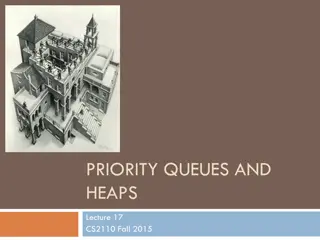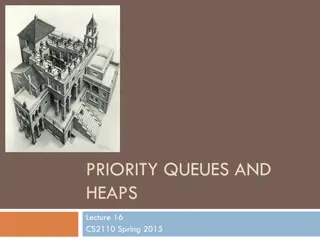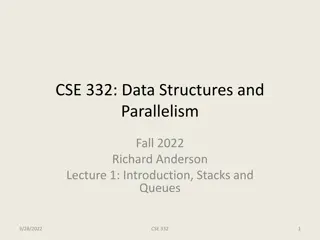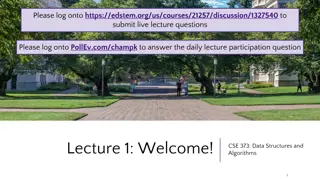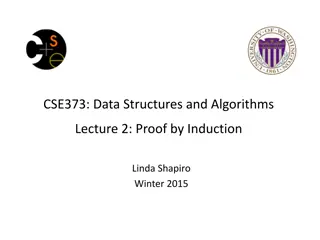CSE 373 Data Structures and Algorithms Lecture Wrap-up: Queues, Asymptotic Analysis, Proof by Induction
In this lecture, we wrapped up discussions on queues, started asymptotic analysis including Big-O notation, and delved into proof by induction. The instructor, Lilian de Greef, covered various topics essential for understanding data structures and algorithms. Additionally, announcements were made regarding office hours, TA-led review sessions, homework assignments, and more. The lecture provided a comprehensive overview of fundamental concepts in computer science.
Download Presentation

Please find below an Image/Link to download the presentation.
The content on the website is provided AS IS for your information and personal use only. It may not be sold, licensed, or shared on other websites without obtaining consent from the author.If you encounter any issues during the download, it is possible that the publisher has removed the file from their server.
You are allowed to download the files provided on this website for personal or commercial use, subject to the condition that they are used lawfully. All files are the property of their respective owners.
The content on the website is provided AS IS for your information and personal use only. It may not be sold, licensed, or shared on other websites without obtaining consent from the author.
E N D
Presentation Transcript
CSE 373: Data Structures and Algorithms Lecture 2: Wrap up Queues, Asymptotic Analysis, Proof by Induction Instructor: Lilian de Greef Quarter: Summer 2017
Today: Announcements Wrap up Queues Begin Asymptotic Analysis: Big-O Proof by Induction
Announcement: Office Hours Announced! See course webpage for times Most held in 3rdfloor breakouts in CSE (whiteboards near stairs) Lilian s additional actual office office hours CSE 220 (a more private environment) During listed times And by appointment! (email me >24 hours ahead of time with several times that work for you) Come talk to me about anything! (feedback, grad school, Ultimate Frisbee, life problems, whatever)
Announcement: Sections When & where: listed on course webpage What: TA-led Review sessions of course material Practice problems Question-answering Optional, but highly encouraged! I wouldn't have passed 332 (Data Structures and Parallelism) without regularly going to section! Vlad (TA)
Other Announcements Homework 1 is out On material covered in Lecture 1 Go forth! or at least get Eclipse set up today. Only required course reading: 10 pages, easy read on commenting style Due beginning of class on Monday July 3rd Not an official UW holiday (sorry guys) But I m declaring it an unofficial holiday! Go enjoy a 4-day July 4th weekend
Finishing up Queues Let s resolve that cliff-hanger!
If we can assume the queue is not empty, how can we implement dequeue()? size-1 0 1 2 Public E dequeue() { size--; E e = array[front]; <Your code here!> return e; } rear i h g f e front for (int i = 0; i < rear; i++) { array[i] = array[i+1] } front++; if (front == array.length) front = 0; C) front++; if (front == array.length) front = 0; A) B) rear = rear-1; if (rear < 0) rear = array.length-1; D) None of these are correct
If we can assume the array is not full, how can we implement enqueue(E e)? size-1 0 1 2 Public enqueue(E e) { <Your code here!> size++; } rear i h g f e front rear++; if (rear == array.length) rear = 0; array[rear] = e; A) for (int i=front; i<rear; i++) { array[i] = array[i+1] } array[rear] = e; rear++; C) B) rear++; array[rear] = e; D) None of these are correct
Between arrays and linked-lists which one *always* is the fastest at enqueue, dequeue, and seeKthElement operations? (where seeKthElement lets you peek at the kth element in the stack) Fastest: enqueue dequeue seeKthElement A) Arrays Linked-Lists Neither B) Linked-lists Neither Neither C) Linked-lists Neither Arrays D) They re all the same
Which ones better? Arrays Linked-lists
Trade-offs! The ability to choose wisely between trade-offs is why it s important to understand underlying data structures. Common Trade-offs Time vs space One operation s efficiency vs another Generality vs simplicity vs performance
Asymptotic Analysis Oh ho! The Big-O!
Algorithm Analysis Why: to help choose the right algorithm or data structure for the job Often in asymptotic terms Most common way: Big-O Notation General idea: A common way to describe worst-case running time
Example #1: Important! Always begin by specifying what n is! (or x or y or whatever letter) The barn is an array of Cows, excitement is an integer, and Cow.addHat()runs in constant time. println("The alien is visiting!"); println("Party time!"); excitement++; for (int i=0; i<barn.length; i++) { Cow cow = barn[i]; cow.addHat(); } Let's assume that one line of code takes 1 "unit of time" to run This is not always true, i.e. calls to non-constant-time methods)
Example #1: println("The alien is visiting!"); println("Party time!"); excitement++; for (int i=0; i<barn.length; i++) { Cow cow = barn[i]; cow.addHat(); }
Example #2: Your turn! for (Person player: sportsTeam) { player.smile(); for (Person teamMate: sportsTeam) { player.say( Good game!"); player.highFive(teamMate); } Assume that the above Person method calls run in constant time
Whats the asymptotic runtime of this (semi-)pseudocode? x := 0; for i=1 to N do for j=1 to i do x := x + 3; return x; A. O(n) B. O(n2) C. O(n + n/2) D. None of the above
Whats the asymptotic runtime of this (semi-)pseudocode? x := 0; for i=1 to N do for j=1 to i do x := x + 3; return x; How do we prove the right answer? Proof by Induction! A. O(n) B. O(n2) C. O(n + n/2) D. None of the above
Inductive Proofs (Interlude from Asymptotic Analysis)
Steps to Inductive Proof 1. If not given, define n(or x or t or whatever letter you use) 2. Base Case 3. Inductive Hypothesis (IHOP): Assume what you want to prove is true for some arbitrary value k (or p or d or whatever letter you choose) 4. Inductive Step: Use the base case and IHOP to prove it's true for n = k+1
Example #0: Example #0: Proof that I can climb any length ladder 1. Let n = number of rungs on a ladder. 2. Base Case: for n = 1 3. Inductive Hypothesis (IHOP): Assume true for some arbitrary integer n = k. 4. Inductive Step: (aiming to prove it's true for n = k+1) If I climb k steps of the ladder, then I have one step left to go. By IHOP, I can climb k steps of the ladder. By Base Case, I can climb the last step. So I can climb k+1 steps. I can climb forever!
Example #1 Prove that the number of loop iterations is ? (? + 1 2 x := 0; for i=1 to N do for j=1 to i do x := x + 3; return x;
Example #2: Example #2: Prove that 1 + 2 + 4 + 8 + + 2n = 2n+1 - 1
Useful Mathematical Property! ? 2?=2?+1 1 ?=0 You ll use it or see it again before the end of CSE 373.
Powers of 2 A bit is 0 or 1 (just two different letters or symbols ) A sequence of n bits can represent 2n distinct things (For example, the numbers 0 through 2n-1) 210is 1024 ( about a thousand , kilo in CSE speak) 220is about a million , mega in CSE speak 230is about a billion , giga in CSE speak Java: an intis 32 bits and signed, so max int is about 2 billion a longis 64 bits and signed, so max long is 263-1
Which means You could give a unique id to Every person in the U.S. with 29 bits Every person in the world with 33 bits Every person to have ever lived with 38 bits (estimate) Every atom in the universe with 250-300 bits So if a password is 128 bits long and randomly generated, do you think you could guess it?
Example #3 Example #3: (Parody) Reverse Induction! Proof by Reverse Induction That You Can Always Cage a Lion: Let n = number of lions Base Case: There exists some countable, arbitrarily large value of M such that when n = M, the lions are so packed together that it's trivial to cage one. IHOP: Assume this is also true for n = k. Inductive Step: Then for n = k-1, release a lion to reduce the problem to the case of n = k, which by the IHOP is true. QED :) Fun fact: Reverse induction is a thing! The math part of the above is actually correct.
